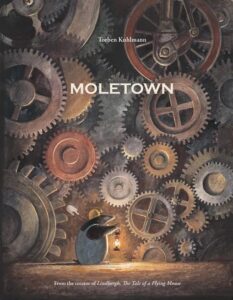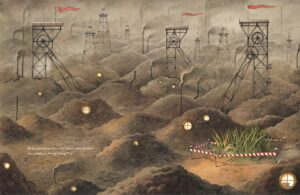 Moletown
Moletown
By Torben Kuhlmann
North/South Books, Inc.
$17.95
ISBN: 978-0-7358-4208-3
Ages 4-6
On shelves October 1st
Cautionary tales for kids who can’t do a darn thing about the original problem. It’s sort of a subgenre of its very own. As I hold this lovely little book, Moletown, in my hands I am transported back in time to the moment I first encountered The Lorax by Dr. Seuss. A child of the 80s, my youth was a time when scaring kids straight was an accepted educational technique utilized in everything from environmental protection to saying no to drugs. The film version of The Lorax bore this out and gave me some nice little bite-sized psychological scars for years to come. These days we don’t usually go in for the whole learning-through-fear technique. Even picture books that sport a message are more prone to be mildly sad than anything else. What makes Moletown so very interesting then is its inclination to tap into popular tropes in our own history, then turn them ever so gently on their heads. The end result is a book where you might easily lose sight of the bigger picture, until that final moment when everything becomes horribly clear.
“The story of Moletown began many years ago.” A single solitary mole moves beneath a meadow to live. Not long thereafter he’s joined by other moles “And over time, life underground changed…” Before our eyes we see it. We see the vast construction projects taking place to make Moletown a livable community. We see the population explosion, the increased technological advances, and different transportation models. Life becomes busier for the moles, while outside in the meadow nature is taking a severe hit. The green is close to disappearing altogether, but turn to the last pages in the book and there we see evidence not just of change, but of the moles as a whole taking on the responsibility of their newly green again meadowlands.
 Kuhlmann initially burst upon the American picture book scene with the highly detailed Lindbergh, a story of a mouse with a yen for flight. A little bit The Arrival, a little bit An American Tale and a little bit steampunk via Beatrix Potter, it was his hyper realistic animals placed in extraordinary circumstances that stayed with young readers. In Moletown that level of detail and attention is there, but the moles have a far more cartoonish feel to them. This is not to say that they don’t look like moles, every inch of them. Yet Kuhlmann has simplified his hyper-realistic renderings of animals and traded that attention in for set designs and landscapes. Here he plays with perspective, plunging us down into the heart of the moles’ mining operation, the scaffolding twisting around and around, down and down. Sharp eyed spotters will note other spreads where the stop signs are shaped like mole claws and the trains go vertically as well as horizontally. The details are there to an elegant degree, but the feel is different from Lindbergh certainly (as is the length of the piece).
Kuhlmann initially burst upon the American picture book scene with the highly detailed Lindbergh, a story of a mouse with a yen for flight. A little bit The Arrival, a little bit An American Tale and a little bit steampunk via Beatrix Potter, it was his hyper realistic animals placed in extraordinary circumstances that stayed with young readers. In Moletown that level of detail and attention is there, but the moles have a far more cartoonish feel to them. This is not to say that they don’t look like moles, every inch of them. Yet Kuhlmann has simplified his hyper-realistic renderings of animals and traded that attention in for set designs and landscapes. Here he plays with perspective, plunging us down into the heart of the moles’ mining operation, the scaffolding twisting around and around, down and down. Sharp eyed spotters will note other spreads where the stop signs are shaped like mole claws and the trains go vertically as well as horizontally. The details are there to an elegant degree, but the feel is different from Lindbergh certainly (as is the length of the piece).
 One of the most amazing aspects of the book is the sense of time passing. In the early days of Moletown you see the immigrants arriving, looking very much like the European immigrants of the late 19th century. As time passes you see moles in Wright Brothers era caps, trench coats and fedoras of the 40s, a possible homage to the MTV image of the 80s (complete with Nintendo video game remotes), and finally the iPods and wind farms of the current age.
One of the most amazing aspects of the book is the sense of time passing. In the early days of Moletown you see the immigrants arriving, looking very much like the European immigrants of the late 19th century. As time passes you see moles in Wright Brothers era caps, trench coats and fedoras of the 40s, a possible homage to the MTV image of the 80s (complete with Nintendo video game remotes), and finally the iPods and wind farms of the current age.
Many European artists find it difficult to break into the American market due to the fact that their art contains a distinctly “foreign” feel. Kuhlmann’s advantage here is that while it is easy enough to believe that the images in this story originated in Germany, there is nothing distinctly “other” about the book . . . at first. It’s only with multiple readings that you begin to notice the elements that probably could not have begun here in the States. For example, in more than one instance you’ll see a mole smoking. This is by no means the focus of the book, and you would have to look somewhat hard to find such moments, but I have seen American parents go ballistic over far lesser crimes in picture book illustration, so I’ve no doubt the occasional library patron will become incensed over what they believe to be the promotion of cigarettes. Other hints that the book is German? Well, I could be wrong but this may well be the only picture book you’ll find on the market today containing a two-page spread dedicated to accountancy.
 One interesting thing about the book is the fact that the ending that we so deeply desire is embedded not in the book itself but in its endpapers. The final text in the book reads, “Many generations later, the moles’ green meadow had completely disappeared. Almost.” Turn the page and rather than provide a verbal explanation, the book gives us a glimpse of a series of photographs alongside an article from The Moletown Times which reads, “Agreement on Green”. The pictures show steps taken to preserve the environment and restore the meadow. I didn’t mind this method of summing up the steps taken to correct the past. Yet more interesting to me, by far, was how the book lets the reader reach their own slow realization that the seemingly inevitable trudge of technological advances and population increases are, in fact, detrimental. That picture at the beginning of the book of the immigrants arriving in Moletown, to an American reader, strikes you as a symbol of freedom from oppression and hardship. And because Kuhlmann keeps the book almost entirely wordless from start to finish, the glimpses of the meadow in its downward slide towards decay are shown without commentary. It’s up to the reader to realize that something has gone very wrong. How many will actually make that leap will be interesting to see.
One interesting thing about the book is the fact that the ending that we so deeply desire is embedded not in the book itself but in its endpapers. The final text in the book reads, “Many generations later, the moles’ green meadow had completely disappeared. Almost.” Turn the page and rather than provide a verbal explanation, the book gives us a glimpse of a series of photographs alongside an article from The Moletown Times which reads, “Agreement on Green”. The pictures show steps taken to preserve the environment and restore the meadow. I didn’t mind this method of summing up the steps taken to correct the past. Yet more interesting to me, by far, was how the book lets the reader reach their own slow realization that the seemingly inevitable trudge of technological advances and population increases are, in fact, detrimental. That picture at the beginning of the book of the immigrants arriving in Moletown, to an American reader, strikes you as a symbol of freedom from oppression and hardship. And because Kuhlmann keeps the book almost entirely wordless from start to finish, the glimpses of the meadow in its downward slide towards decay are shown without commentary. It’s up to the reader to realize that something has gone very wrong. How many will actually make that leap will be interesting to see.
Finding books to compare this one to can be difficult. The overall feeling I got was like the one in The Rabbits by John Marsden. But where that was a story of a culture being systematically destroyed, this has a sweeter if no less destructive feel. The Lorax hits the same environmental notes, but Moletown is the subtler of the two since it makes the reader implicit in the enjoyment one derives from Moletown’s culture (and from the fact that it’s a world that feels very much like our own). The best way to describe the story is to say that it’s a combination of the two, with a hopeful endnote all its own. Like all imports, it runs its greatest risk in becomes a forgotten piece since it can’t win many of our American children’s book awards. That said, I have faith that teachers, parents, and students will find in it a new approach to tackling the tricky subject of mass consumption vs. environmental action. Explicit in its message. Subtle in its presentation. In short, a beaut.
On shelves October 1st.
Like This? Then Try:
The Lorax by Dr. Seuss
The Rabbits by John Marsden, illustrated by Shaun Tan
The Promise by Nicola Davies


